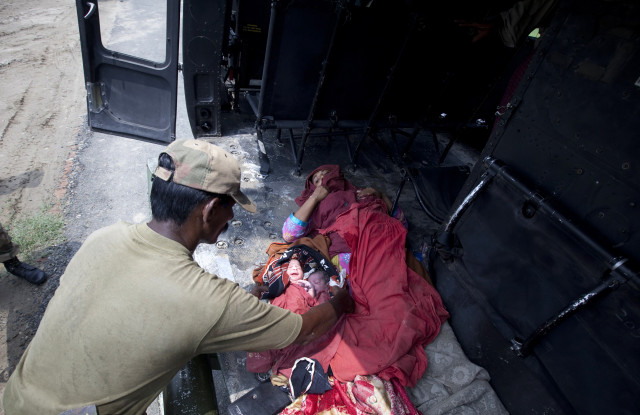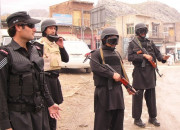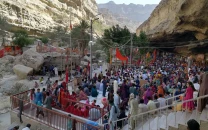As the waters flow, some break
Sodhi gave birth to a baby girl on Sunday, a day after her family was shifted to a relief camp in Khairpur.

Sodhi’s family relocated from Kashmore and was grateful that there were two female doctors present at the camp, who supervised the delivery.
The birth of Sodhi’s baby is just the first among the eight more births expected to occur in this camp any day now.
Five out of these eight women are already in their tenth month of pregnancy.
Aisha from Umrani Goth, Sahiba from Humayun village, Wahdal Mai who is a member of the Jaffri Baloch tribe from Karampur in Kashmore, Kadal Mai, also from the same tribe and Jan Bibi from Sultan Goth.
The remaining three —Zarina, Rehmat Mai and Madina Mai - are in their ninth month and hail from Shikapur.
Four doctors, two of whom are women, have been deputed at this relief camp, established inside Government High School Baber Loh. But doctor incharge Faiz Bugti complained that the relief camps were too dirty. “If this place is not cleaned then there is a risk that an outbreak of diseases will affect the children,” he said.
The flood grapevine
As the waters flowed into Guddu Barrage Monday evening, rumours leaked out.
The current rumour is that the Ghulam embankment, made over the Sukkur Barrage, will be dynamited to save the barrage. But this is far from reality. There is no threat to the barrage, hence, there is no plan to blow it up.
The rumour seems to be based on history. The Ghulam embankment was dynamited in the 1976 floods to protect the barrage.
The most astonishing rumour was that the army and Sindh government were at loggerheads with the army wanting to break the Ghulam embankment and the government opposing it. Another amusing buzz was that federal Labour Minister Khursheed Shah has been taken into army custody for opposing the breach in the Ghulam embankment. A flaming addition was that the Army chief Ashfaq Parvez Kayani only came to visit the area to resolve the Ghulam bund issue.
Some may be true
One rumour that is starting to seem true is that bodies from south Punjab have flowed into Sindh via the Guddu Barrage. People have reported that bodies were seen flowing into the province but the flow is so fast that the villagers can only watch them rush past.
Villagers, who were stranded in the kachcha areas over the last week and have been saved, described the scene. “There may be hundreds of these bodies,” one villager claimed. “We didn’t know things would be this bad.”
Another rumour is over 20,000 people have died across the country.
Camp life
Most of the people who have been forced to evacuate their homes and shift to relief camps were living in the kachcha areas. Their main occupation is herding animals which is why they have brought along any of the livestock that has survived.
Families had initially tied their animals in the garden inside Baber Loh school but they were afraid that their animals might be stolen. Now the families have decided to tie their animals right outside their tents so they are under their constant watch.
Maluka Bijrani, one of the flood victims living in the camp, appreciated the government’s efforts but she was unsatisfied with the medical facilities.
“We are broke and don’t have money to go back to our villages,” she said, hoping that the government will not leave them stranded and give them compensation when they return.
Maluka’s family of 40 people cannot fit inside their tent as it gets suffocating. They prefer to lie down on a platform in the middle of the school grounds where they can at least breathe fresh air.
Bee Bai from Kashmore, who appears to be 60 but claims she is 40 years old, said that her family left their house with the clothes on their back. “We have left behind all our personal belongings. We only managed to bring two goats and three sheep with us,” she explained. There were 1,200 displaced persons in the camp on Sunday evening and trucks have continuously been bringing in more people.
By Monday evening, the authorities were able to shift several people to camps set up in other parts of Khairpur, such as Garhi Mori Girls School, where the affected people will be given tents and food. Around 712 people remained at Baber Loh and it was expected that 250 among them would be relocated soon.
The EDO Revenue also directed the scouts to maintain a database of all families who arrive at the camp, with special instructions to record the names of the head of the family. The scouts will start collecting the data early Tuesday.
‘It’s each man for himself’
When you see the panicked expressions on the faces of the residents of flood-hit areas, it is enough to give you goose bumps that have nothing to do with the torrential rains.
“Every man for himself - that is the rule that these people are following,” claimed our correspondent from Sukkur, Shahzad Tabani, who has been visiting the affected areas everyday. He has reported from villages drowned in knee-deep water that were once homes to thousands of people.
“Even when they see someone in distress, no one stops to help because everyone is trying to save their own life,” he said, adding that, “no normal person can go to these areas because the destruction is phenomenal”.
The kachcha area in Kashmore used to have lush green fields dotted with farmers and their families. Residents of Kashmore take pride in their homemade butter, which the women churned at the river side.
Today, a visitor in Kashmore will only see “water everywhere”, said Tabani.
According to him, most of the possessions of the residents washed away in the flood. Whatever they managed to save, they carried it as they started walking towards safer ground.
The families, along with their livestock, walk at least 50 kilometres every day as there is no transport available and most roads have broken down. As soon as it becomes dark, they stop wherever they are and wait for sunrise.
“They are scared to sleep at night because they never know when a big calamity might occur and they are washed away,” Tabani explained.
Sights of trucks overflowing with people and livestock are common in the area these days but the woes of the people do not end upon reaching the relief camps. The camps have no roofs and the electricity supply has been suspended for the past four days due to the continuous rains.
“These families have experienced hell on earth,” Tabani felt. Almost 23,000 families from Jacobabad relocated to Kandhkot when their homes were threatened. However, several more embankments broke down. When the water started entering Kandhkot, a group of men from these families, dug a hole on the main road on Monday to divert the water back to their original homes so that their temporary shelters were not flooded.
WITH WRITING BY NEHA ANSARI AND
HIRA SIDDIQUI
Published in The Express Tribune, August 10th, 2010.



















COMMENTS
Comments are moderated and generally will be posted if they are on-topic and not abusive.
For more information, please see our Comments FAQ